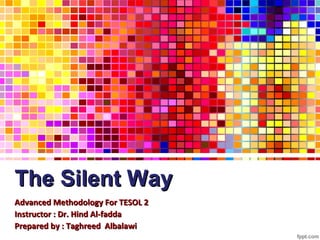
The silent way
- 1. The Silent Way Advanced Methodology For TESOL 2 Instructor : Dr. Hind Al-fadda Prepared by : Taghreed Albalawi
- 2. بسم ا الرحمن الرحيم
- 3. Background • The Silent Way, developed in the 1960s by Caleb Gattegno, is grounded in the belief that students should learn independently of the teacher. Gattegno proposed that students would learn better if they developed personal responsibility for their own learning. Thus, for much of the lesson, the teacher remains silent. Teaching is viewed as subordinate to learning.
- 4. Background • Students are encouraged to work with one another to figure out meaning. Students are introduced to new material once through the use of Cuisenaire rods (small colored rods of varying lengths) and a series of wall charts. After the teacher introduces the material, it is up to the students to determine what they need to learn and independently work toward their academic goals.
- 5. Background • Certain aspects of this approach, such as the use of Cuisenaire rods and developing student independence, continue to be used. However, this approach alone is rarely used because it is not practical within the class room, and students need and desire more teacher input.
- 6. Objective The objective of The Silent Way Method of language teaching is for students to work as independent language learners.
- 7. Learning Hypotheses • Learning is facilitated if the learner discovers or creates rather than remembers and repeats what is to be learned. • Learning is facilitated by accompanying (mediating) physical objects. • Learning is facilitated by problem solving involving the material to be learned.
- 8. Tell me and I forget , Teach me and I remember, Involve me and I learn.
- 9. Theory of Learning • Gattegno makes extensive use of his understanding of first language learning processes as a basis for deriving principles for teaching foreign languages to adults. Gattegno recommends that the learner needs to "return to the state of mind that characterizes a baby's learning surrender"
- 10. Theory of Learning • A successful learning involves commitment of the self to language acquisition through the use of silent awareness and then active trial. • Silent Way learners acquire “inner criteria”. • The Silent Way students are expected to become independent , responsible and autonomous .
- 11. Silent way principles • The teacher should start with something the students already know and build from that to the unknown. • Language learners are intelligent and bring with them the experience of already learning a language. • Language is not learned by repeating after a model. • Students should learn to rely on each other and themselves. • Learning involves transferring what one knows to new contexts. • Silence is a tool. It helps to foster autonomy, or the exercise of initiative. The teacher speaks, but only when necessary
- 12. Silent way principles • Meaning is made clear by focusing students’ perceptions, not through translation. • If the teacher praises (or criticizes) students, they will be less self-reliant. • Errors are important and necessary to learning. • At the beginning, the teacher needs to look for progress, not perfection. Learning takes place in time. Students learn at different rates. • Students learn they must give the teacher their attention in order not to miss what he says. Student attention is a key to learning.
- 13. Silent way principles • Students should engage in a great deal of meaningful practice without repetition. • Language is for self-expression. • The teacher can gain valuable information from student feedback. • The syllabus is composed of linguistic structures. • The structures of the syllabus are not arranged in a linear fashion, but rather are constantly being recycled. • The skills of speaking, reading, and writing reinforce one another.
- 14. Materials & Techniques Sound chart •The sound-color chart consists of blocks of color, with one color representing one sound in the language being learned
- 16. Materials & Techniques Word charts •The word charts contain the functional vocabulary of the target language, and use the same color scheme as the sound-color chart. Each letter is colored in a way that indicates its pronunciation.
- 23. Materials & Techniques Fidel •The Fidel is a set of charts presenting all the possible spellings of each sound of the language using the same colour code as the Sound/colour rectangle chart and Word Charts.
- 25. Materials & Techniques Cuisenaire rods •The Cuisenaire rods are wooden, and come in ten different lengths, but identical cross-section; each length has its own assigned color.
- 27. Materials & Techniques Pointer •The teacher uses the pointer to indicate a sound symbol for the students to produce.
- 28. Materials & Techniques Other materials & Techniques •Teacher’s silence . •Stretchered feedback •books and worksheets for practicing reading and writing skills, picture books, tapes; videotapes, films, gestures and other visual aids
- 29. Strategy • The teacher introduces a discrete sound or structure by pointing at Silent Way charts or by using Cuisenaire rods to demonstrate a structure or grammar point. • Students then figure out what they are learning and reproduce the sound or structure. • Between activities or sessions, students may ask questions of the teacher.
- 30. Strategy • The teacher then introduces another discrete sound or structure in the same manner. • Students again figure out the meaning and reproduce the sound or structure. • As time goes on, students are ideally able to combine discrete sounds and structures to create longer strings of language.
- 31. Recommended website •Educational solutions
- 32. و ما ت و في قي إ ِ ل بال ل ه ع ل ي ه ّ ِ ّ ِ ََْ ِ )َ َ َ ْ ِ ِ ت و ك ل ت و إ ِ ل ي ه أ ُ ني ب( َ َ ّْ ُ َ َْ ِ ِ ُ